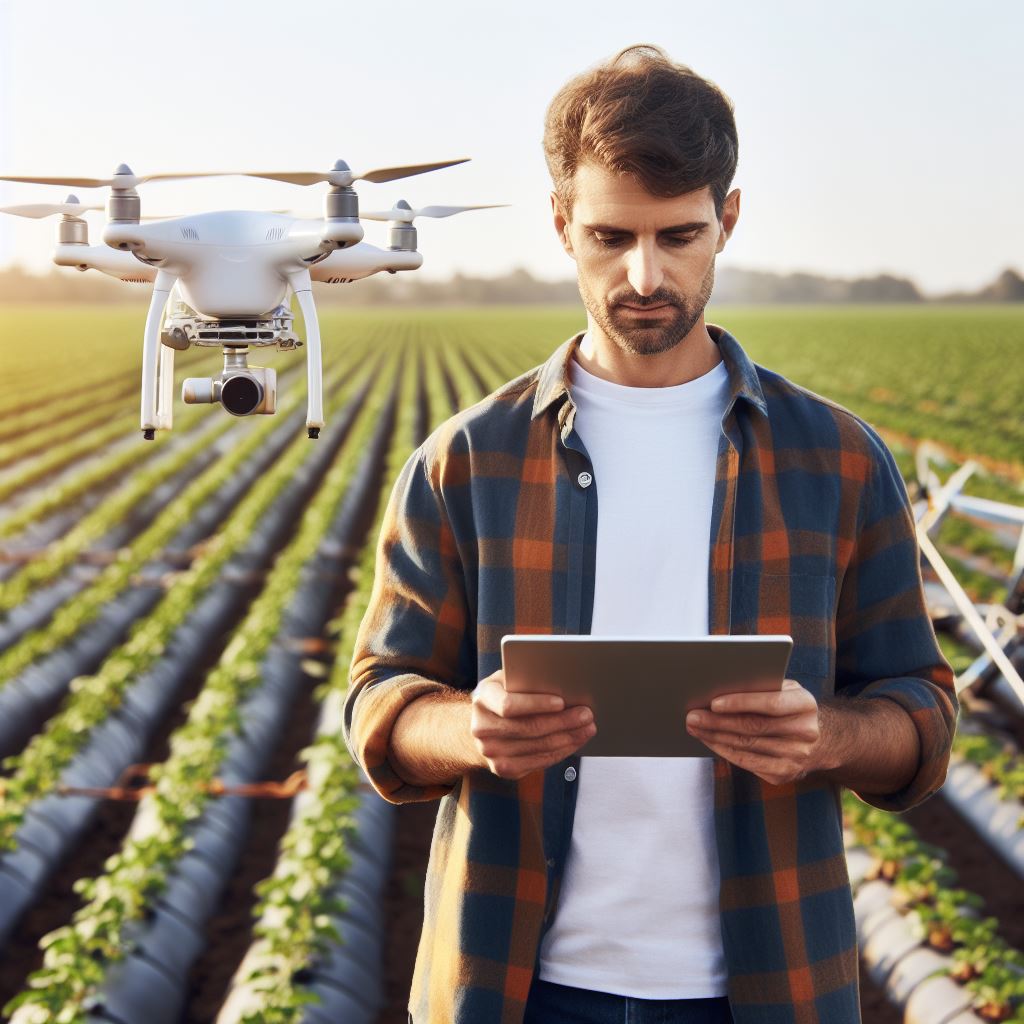Introduction
Agricultural engineering plays a crucial role in the United States, ensuring the success and efficiency of the agricultural sector.
Innovative projects have been instrumental in shaping this field, driving advancements and increasing productivity.
A. Importance of agricultural engineering in the US
Agricultural engineering is vital for the US as it aids in improving agricultural practices, increasing yields, and reducing operational costs.
This field focuses on applying engineering principles to solve agricultural challenges, such as automation, precision agriculture, and sustainable farming practices.
B. Role of innovative projects in shaping the field:
Innovative projects have significantly impacted agricultural engineering, leading to advancements in technology and techniques.
Projects like the development of precision farming technologies, such as GPS-guided equipment and remote sensing, have revolutionized farming practices.
These advancements allow farmers to optimize inputs, monitor crops, and reduce environmental impact.
Furthermore, innovative projects in the field have led to the design and implementation of automated machinery, reducing labor requirements and increasing efficiency.
Robots and drones are now used for tasks like planting, spraying, and monitoring crops, providing accurate and timely data for decision-making.
The integration of renewable energy sources, such as solar panels and wind turbines, into agricultural systems is another remarkable area of innovation.
By harnessing clean energy, farms can reduce their reliance on fossil fuels and minimize their carbon footprint.
Basically, agricultural engineering plays a crucial role in the United States, and innovative projects continue to shape its development.
These projects drive advancements in technology, improve efficiency, and enhance sustainability in the agricultural sector.
With ongoing innovation, the field is poised to tackle future challenges and ensure a resilient and productive farming industry.
Overview of Agricultural Engineering
Agricultural engineering is a field of engineering that focuses on finding solutions to agricultural problems.
It encompasses various areas such as machinery, structures, soil and water management, and automation.
The goal of agricultural engineers is to improve productivity, efficiency, and sustainability in the agricultural sector in the United States.
A. Definition and Scope of Agricultural Engineering
- Definition: Agricultural engineering is the application of engineering principles to solve agricultural problems and improve farming practices.
- Scope: Agricultural engineering involves designing and developing new technologies, tools, and systems to enhance agricultural processes and address challenges in the field.
B. Key Areas of Focus
Agricultural engineering covers several key areas that contribute to the advancement of the agricultural industry in the US.
These areas include:
- Machinery: Agricultural engineers design and develop machinery and equipment that streamline farming operations, such as tractors, harvesters, and irrigation systems.
- Structures: They design structures like barns, sheds, and greenhouses, ensuring that they provide optimal conditions for livestock and crop growth.
- Soil and Water Management: Agricultural engineers develop techniques for efficient land and water use, preventing soil erosion and optimizing irrigation practices.
- Automation: They implement automation and robotics in agriculture to improve efficiency and accuracy in tasks such as planting, harvesting, and sorting.
- Environmental Sustainability: Agricultural engineers work towards sustainable practices by minimizing the environmental impact of agricultural activities, promoting soil and water conservation, and reducing waste.
C. Impact of Agricultural Engineers
Agricultural engineers play a crucial role in improving productivity, efficiency, and sustainability in the US agricultural sector.
Their contributions have a significant impact on various aspects of farming:
- Increased Productivity: Agricultural engineers develop advanced machinery and tools that enable farmers to increase their yield and overall productivity.
- Efficient Resource Management: Through their expertise in soil and water management, agricultural engineers help farmers optimize resource usage and reduce waste.
- Improved Crop Quality: By designing and implementing innovative farming techniques, agricultural engineers contribute to the production of high-quality crops with minimal environmental impact.
- Enhanced Livestock Management: Agricultural engineers design structures, equipment, and systems that provide a conducive environment for livestock, resulting in better animal welfare and higher-quality products.
- Technological Advancements: Agricultural engineers drive technological innovation in the agriculture industry, leading to the adoption of cutting-edge solutions and practices.
All in all. agricultural engineering encompasses various disciplines and plays a vital role in shaping the US agricultural sector.
By focusing on machinery, structures, soil and water management, automation, and sustainability, agricultural engineers contribute to improving productivity, efficiency, and overall sustainability in farming practices.
Innovative Projects in Machinery Design
A. Advancements in precision agriculture: GPS-based systems, drones, and autonomous machinery
Advancements in precision agriculture have led to the development of sophisticated machinery, revolutionizing the way farming is done in the United States.
With the introduction of GPS-based systems, drones, and autonomous machinery, farmers can now optimize their operations for increased productivity and efficiency.
One of the key advancements in machinery design is the implementation of GPS-based systems.
These systems use satellite technology to accurately map fields and guide machinery for precise planting, spraying, and harvesting.
By utilizing this technology, farmers can reduce the use of inputs such as seeds, fertilizers, and pesticides, resulting in cost savings and minimizing the environmental impact.
Another exciting development in machinery design is the use of drones in agriculture.
Drones equipped with advanced imaging sensors and cameras can capture aerial data of the crops.
This enables farmers to monitor crop health, detect pest infestations, and make informed decisions regarding irrigation and fertilizer application.
The use of drones eliminates the need for manual scouting, saving time and resources.
B. Development of smart farming equipment and robotic technologies
Furthermore, the rise of smart farming equipment and robotic technologies has transformed the agricultural landscape.
These innovative machines integrate data analytics, artificial intelligence, and automation to optimize farming practices.
For instance, autonomous robots capable of selective weed removal can precisely target and eliminate weeds, reducing the dependence on herbicides.
C. Case studies of innovative machinery projects in the US
Several successful case studies highlight the implementation of innovative machinery projects in the US. One notable example is the use of robotic strawberry harvesters.
These robots are equipped with sensors and algorithms to identify ripe strawberries and delicately pick them without damaging the fruit.
This technology has proven to be efficient and cost-effective, addressing labor shortages in the agricultural sector.
Another remarkable project is the development of automated lettuce transplanters.
These machines can accurately plant thousands of lettuce seedlings in a short period, ensuring proper spacing and reducing manual labor.
This technology increases planting efficiency and improves crop uniformity.
Transform Your Career Today
Unlock a personalized career strategy that drives real results. Get tailored advice and a roadmap designed just for you.
Start NowAdditionally, there have been advancements in the design of robotic dairy milkers.
These machines use sensors and robotic arms to identify and milk cows without human intervention.
The robotic milkers can monitor each cow’s milk production and health metrics, providing valuable data for herd management.
Generally, innovative machinery projects are shaping the field of agricultural engineering in the US.
The utilization of GPS-based systems, drones, and autonomous machinery are bringing significant advancements in precision agriculture.
Furthermore, the development of smart farming equipment and robotic technologies is revolutionizing farming practices and addressing labor shortages.
These innovative projects not only increase productivity and efficiency but also contribute to sustainable and environmentally friendly farming practices.
Contributions of Agricultural Engineering to Sustainable Farming
Agricultural engineering plays a crucial role in shaping the future of farming by incorporating innovative solutions to address sustainability challenges.
Here are some key contributions:
A. Integration of renewable energy sources in agricultural operations
The integration of renewable energy sources in agriculture helps promote sustainability while reducing costs for farmers.
Solar panels, for example, can power irrigation systems, reducing the reliance on grid electricity and lowering greenhouse gas emissions.
Wind turbines can generate electricity to run farm machinery, further contributing to clean energy production.
Agricultural engineers collaborate with renewable energy experts to design and implement efficient energy systems tailored to specific agricultural operations.
B. Water and nutrient management techniques to reduce environmental impact
Water and nutrient management techniques developed by agricultural engineers have a significant impact on reducing the environmental footprint of farming.
Precision irrigation systems, such as drip irrigation and soil moisture sensors, ensure that crops receive the right amount of water at the right time, minimizing wastage.
Advanced nutrient management, like controlled-release fertilizers and variable rate application, optimizes usage, preventing water pollution and excessive fertilizer use.
C. Use of big data and AI in optimizing farming practices
The utilization of big data and AI technologies revolutionizes farming practices by enabling farmers to make data-driven decisions.
Agricultural engineers collect and analyze large datasets from various sources such as sensors, satellites, and weather stations.
They use this information to create models that predict crop performance, disease outbreaks, and pest infestations.
Farmers can then make informed decisions about irrigation scheduling, fertilizer application, and pest control, optimizing productivity while reducing resource usage and environmental impact.
Overall, agricultural engineering plays a crucial role in shaping sustainable farming practices.
By integrating renewable energy sources, optimizing water and nutrient management.
And utilizing big data and AI technologies, agricultural engineers contribute to reducing environmental impact, improving resource efficiency, and ensuring the long-term sustainability of the agricultural sector.
Read: Financial Prospects of Animal Breeding in the USA
Role of Agricultural Engineering in Food Safety and Processing
Agricultural engineering plays a crucial role in ensuring food safety and efficient processing.
Through the development and implementation of innovative technologies, agricultural engineers are revolutionizing the way food is produced, processed, and preserved.
A. Technologies enhancing food safety and traceability
- Advanced sensors and monitoring systems are used to detect contaminants and ensure the quality of food products.
- Traceability systems enable the tracking of food from farm to fork, ensuring transparency and quick response in case of contamination.
- Automated quality control systems reduce the risk of human error and improve the accuracy of safety inspections.
- Food safety data analytics help identify potential hazards and develop preventive measures for better risk management.
- Novel packaging technologies, such as intelligent packaging with sensors, extend shelf life and enhance safety by monitoring product conditions.
B. Automation and robotics in food processing and packaging
- Robots are increasingly being used in food processing plants to automate repetitive tasks, enhancing efficiency and reducing labor costs.
- Automated sorting and grading systems ensure consistent quality and reduce the reliance on manual labor.
- Robot-assisted packaging improves speed, accuracy, and hygiene in the packaging process, minimizing contamination risks.
- Vision systems and machine learning algorithms enable robots to identify defects, sort products, and enhance quality control.
- Automated palletizing and storage systems optimize warehouse operations, increasing throughput and minimizing product damage.
C. Innovations in crop storage and preservation techniques
- Modified atmosphere packaging (MAP) and controlled atmosphere storage (CAS) techniques prolong the shelf life of fruits and vegetables.
- Smart drying technologies, such as infrared and microwave drying, reduce energy consumption and improve the quality of dried products.
- Cold storage systems with precise temperature and humidity control prevent spoilage and maintain the nutritional value of perishable goods.
- Novel preservation methods, like high-pressure processing and pulsed electric fields, kill bacteria and extend the shelf life of food products.
- Vacuum packaging and aseptic processing techniques preserve the freshness and integrity of liquid and semi-liquid food products.
In a nutshell, agricultural engineering plays a vital role in ensuring food safety and efficient processing.
Agricultural engineers contribute to high-quality, safe food production using innovative tech like advanced sensors, automation, and preservation methods.
Read: Ethical Practices for Animal Breeders: US Standards

Impact of Agricultural Engineering in Urban Agriculture
Urban agriculture is an emerging trend that is rapidly gaining popularity in cities across the United States.
With limited space and resources, innovative projects in agricultural engineering have been developed to maximize productivity and efficiency in urban settings.
These projects have had a significant impact on the growth and sustainability of urban agriculture.
A. Vertical farming and urban rooftop gardens
One of the key innovative projects in agricultural engineering contributing to urban agriculture is vertical farming.
Vertical farming involves the cultivation of crops in vertically stacked layers, using integrated systems that regulate temperature, lighting, and nutrient supply.
This method allows for increased crop yield in a smaller footprint, making it ideal for urban environments where space is limited.
B. Use of hydroponics and aeroponics systems
Another innovative approach in urban agriculture is the use of hydroponics and aeroponics systems.
Hydroponics involves growing plants in nutrient-rich water, while aeroponics involves misting the roots of plants with nutrient-rich solutions.
These soil-less cultivation techniques require less water and space compared to traditional farming methods, making them ideal for urban areas.
Furthermore, these systems can be implemented indoors, allowing for year-round production without being affected by seasonal changes.
C. Implementation of smart city agriculture projects
In addition to vertical farming and soil-less cultivation, the implementation of smart city agriculture projects has also had a significant impact.
Smart city agriculture projects involve the integration of advanced technologies and data analytics to optimize crop production.
Sensors and automation systems are used to monitor and control factors such as temperature, humidity, and water levels, ensuring optimal growing conditions.
This precision agriculture approach minimizes resource wastage and maximizes crop yield, making it an efficient solution for urban agriculture.
The adoption of innovative projects in agricultural engineering has revolutionized urban rooftop gardening.
Rooftop gardens utilize underutilized roof spaces to grow a variety of crops, reducing heat island effects and improving air quality.
These gardens not only provide fresh produce but also contribute to the beautification of urban landscapes.
The impact of agricultural engineering in urban agriculture extends beyond food production. It also has economic and social benefits.
The implementation of these innovative projects has created job opportunities in urban areas and fostered community engagement.
Urban residents can actively participate in the cultivation of their food, promoting healthy eating habits and enhancing food security.
Moreover, urban agriculture contributes to sustainable development and environmental conservation.
By reducing the reliance on long-distance food transportation, it minimizes carbon emissions and energy consumption.
Additionally, the integration of renewable energy sources such as solar panels in smart city agriculture projects further reduces the carbon footprint of urban agriculture.
Transform Your Career Today
Unlock a personalized career strategy that drives real results. Get tailored advice and a roadmap designed just for you.
Start NowTo sum it up, the impact of agricultural engineering in urban agriculture is significant.
Innovative projects such as vertical farming, hydroponics, aeroponics, and smart city agriculture have revolutionized food production in urban areas, maximizing productivity and efficiency.
These projects not only address the challenges of limited space and resources but also contribute to sustainable development, economic growth, and community engagement.
As urban populations continue to grow, the importance of agricultural engineering in urban agriculture will only continue to increase.
Read: Day in the Life: Following a US Animal Breeder
Collaborations and Funding for Innovative Agricultural Engineering Projects
Research institutions and organizations play a vital role in supporting agricultural engineering initiatives.
These institutions provide the necessary resources, expertise, and collaboration opportunities to drive innovation and enhance the overall development of the field.
Government grants and funding opportunities play a significant role in promoting and sustaining innovative agricultural engineering projects.
These grants provide financial support for research, development, and implementation of cutting-edge technologies and methodologies in the agricultural sector.
The private sector also plays a crucial role in driving innovation in the field of agricultural engineering.
Private sector partnerships enable research institutions and organizations to access additional funding, expertise, and resources necessary to undertake innovative projects.
These partnerships help bridge the gap between academia and industry, fostering collaboration and knowledge exchange.
A. Research Institutions and Organizations Supporting Agricultural Engineering Initiatives
Research institutions and organizations such as universities, agricultural research centers, and non-profit organizations are actively involved in supporting innovative agricultural engineering projects.
These entities provide a collaborative platform for researchers, engineers, and experts to come together and develop solutions to the challenges faced by the agricultural sector.
These organizations often have dedicated departments and research units focused on agricultural engineering.
They conduct research, provide technical assistance, and offer training programs to enhance the capacity of professionals working in the field.
Additionally, they establish partnerships with other stakeholders such as farmers, agribusinesses, and government agencies to ensure the practical applicability of their research outcomes.
Research institutions and organizations also organize conferences, workshops, and seminars, creating opportunities for knowledge dissemination and networking among professionals in the field.
These platforms enable experts to showcase their innovative projects, exchange ideas, and collaborate on future initiatives.
B. Government Grants and Funding Opportunities
Government grants and funding opportunities play a crucial role in supporting innovative agricultural engineering projects.
These grants are typically provided by federal, state, or local government agencies to promote research, development, and adoption of advanced technologies and techniques in the agricultural sector.
Government grants often focus on specific areas of agricultural engineering, such as precision agriculture, automation, sustainable farming practices, and renewable energy in agriculture.
These grants enable researchers and engineers to explore new technologies, conduct experiments, and develop prototypes that have the potential to revolutionize the industry.
In addition to financial support, government agencies also provide technical assistance and access to infrastructure and facilities necessary for conducting research and implementing projects.
They collaborate with research institutions and organizations to align research goals with the needs of the agricultural industry.
C. Role of Private Sector Partnerships in Driving Innovation
Private sector partnerships play a vital role in driving innovation in the field of agricultural engineering.
Collaborating with private companies provides research institutions and organizations with access to additional funding and resources that are essential for undertaking large-scale innovative projects.
Private sector partnerships also facilitate the transfer of knowledge and technology from academia to industry.
Researchers and engineers collaborate with industry experts to develop practical solutions addressing farmers, agribusinesses, and stakeholders’ specific needs and challenges.
Furthermore, private sector partnerships create opportunities for commercialization and market entry of innovative agricultural engineering products and services.
Private companies often have the necessary distribution networks, marketing expertise, and industry connections to successfully bring innovative technologies to the market.
In review, collaborations and funding are essential for driving innovation in agricultural engineering.
Research institutions, government grants, and private sector partnerships all contribute to the development and implementation of innovative projects that address the challenges faced by the agricultural sector.
Through collaboration and financial support, the field of agricultural engineering can continue to evolve and pave the way for a more efficient, sustainable, and prosperous agricultural industry.
Read: Challenges Faced by Modern US Animal Breeders
Challenges and Future Directions
As the field of agricultural engineering continues to advance and shape the future of farming in the United States, there are several challenges and future directions that need to be addressed.
A. Addressing Technological and Infrastructural Limitations
- Developing advanced technologies to improve efficiency and productivity in farming operations.
- Improving access to high-speed internet and connectivity in rural areas to enable the adoption of precision farming techniques.
- Enhancing the development of sustainable and cost-effective energy solutions for agricultural operations.
- Investing in infrastructure development to support the implementation of new technologies and practices.
B. Promoting Diversity and Inclusivity in the Agricultural Engineering Sector
- Encouraging and supporting women and underrepresented groups to pursue careers in agricultural engineering.
- Creating educational programs and scholarships specifically targeted towards diversifying the field.
- Establishing mentorship and networking opportunities for minorities in the agricultural engineering sector.
- Promoting a culture of inclusivity and equality in research and development efforts.
C. Emerging Trends and Areas of Future Development in the US
- Precision agriculture: Utilizing sensor technologies and data analytics to optimize crop production.
- Robotics and automation: Developing autonomous machines for tasks like planting, harvesting, and pest control.
- Biotechnology and genetic engineering: Modifying crops for improved traits and disease resistance.
- Sustainable agriculture: Implementing environmentally friendly practices to minimize the ecological footprint.
- Vertical farming: Utilizing indoor vertical spaces for year-round crop production in urban areas.
- Climate change resilience: Developing strategies to mitigate the effects of climate change on agriculture.
These emerging trends and areas of future development in the US agricultural engineering sector hold great potential to revolutionize the way we produce food and tackle pressing global challenges.
However, it is essential to overcome the challenges posed by technological and infrastructural limitations.
By investing in research and development, improving accessibility, and fostering a diverse and inclusive workforce, we can unlock the full potential of agricultural engineering in the United States.
Transform Your Career Today
Unlock a personalized career strategy that drives real results. Get tailored advice and a roadmap designed just for you.
Start NowThe future of agricultural engineering in the US depends on collaborative efforts between government, academia, industry, and farmers.
By working together, we can address the challenges and create a sustainable and resilient agricultural system that meets the needs of a growing population while preserving our planet’s resources.
As we look ahead, it is crucial to constantly innovate and adapt to emerging trends, keeping a keen eye on technological advancements and continuously improving practices.
By doing so, we can shape a brighter future for agriculture in the United States, ensuring food security and sustainability for generations to come.
See Related Content: Health Benefits and Risks: Life as a US Fisherman
Conclusion
In this section, we explored several innovative projects that are shaping the field of agricultural engineering in the United States.
These projects highlighted the use of advanced technologies and sustainable practices to improve productivity and efficiency in the agricultural sector.
We discussed how smart farming systems and precision agriculture techniques are revolutionizing traditional farming methods by enabling farmers to make data-driven decisions and optimize resource management.
Furthermore, we examined the role of robotics and automation in addressing labor shortages and increasing productivity.
The development of autonomous agricultural machinery and drone technology has shown great potential in performing tasks such as planting, monitoring crops, and harvesting with precision and accuracy.
Additionally, we touched upon the importance of integrating renewable energy sources into agricultural operations.
The emergence of solar-powered irrigation systems and biofuel production for farm machinery has not only reduced dependence on fossil fuels but also contributed to environmental sustainability.
The continuous innovation in agricultural engineering is crucial for the future of the field.
With the rapidly growing global population and the increasing demand for food, it is essential to find sustainable and efficient solutions to meet these challenges.
By incorporating advancements in technology, such as artificial intelligence and big data analytics, agricultural engineers can further improve crop yields, nutrient management, and pest control.
In the end, agricultural engineering’s future appears promising, with ongoing research and development to enhance farming, reduce environmental impact, and boost productivity.
It is an exciting time for the field as it plays a vital role in ensuring food security and sustainable farming practices.




